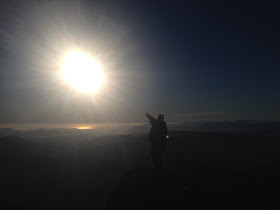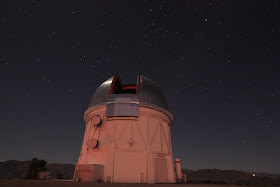 |
| The organizer of our trip, Tim Spuck, helped me take this image! The sliver dome is the Blanco Telescope, which has been doing great science since 1974. |
On Tuesday morning we flew to La Serena, a smaller city much farther north in Chile than Santiago.
 |
| Santiago to La Serena. Image Credit: Sarah Komperud and Google Maps. |
We traveled to the Association of Universities for Research in Astronomy (AURA) headquarters. AURA is an organization started by the National Science Foundation that manages many Chilean telescopes, including Gemini Observatory, National Radio Astronomical Observatory (which includes SOAR and CTIO), National Solar Observatory, and the Space Telescope Science Institute.
At AURA we met with Chilean astronomers and the people who do Education and Public Outreach for Gemini South and CTIO.
 |
| Leonor, head of Outreach for CTIO. |
 |
| Maria Antonieta, head of Outreach for Gemini South. |
 |
| Peter Moore explains a component of the DECam, the Dark Energy Camera. |
 |
| The electronics lab is very well organized. There is a staff person with a degree in Library Science documents all the work they do on the many different telescopes they service. |
 |
| Nichole is an Optical Engineer working on the SAM camera for the LSST, which is under construction now (more on that later!) Science is for Girls! |
 |
| Science! |
 |
| These actuators for Gemini are made from cylinders of stainless steel. Each one takes over 4 hours to make. |
Tuesday evening we traveled to Cerro Mayu, a tourist observatory. It was gorgeous.
 |
| Lots of time in the bus. |
 |
| Image Credit: Tim Spuck |
 |
| The observatory is on a terraced hill where grapes and papaya are grown. Image Credit: Tim Spuck. |
 |
| The observatory had sculptures based on the constellation myths of native South Americans. Image Credit: Tim Spuck |
 |
| The night sky here is gorgeous. It is so clear, the stars take your breath. Image Credit: Tim Spuck. |
We went back to the AURA offices on Wednesday, where we met Dr. Chris Smith, the head of AURA, and Dr. Rodrigo Carrasco, who told us about current science being done on Gemini. Gemini is able to take incredibly high resolution images, especially with the new adaptive optics to correct for interference.
| Orion "Bullets" w/GeMS. In the outskirts of the Orion Nebula, blue spots are clouds of gaseous iron "bullets" being propelled at supersonic speeds from a region of star formation outside of this image's view. Image Credit: Gemini Observatory/AURA 2013.01.09 |
We drove two hours up to Cerro Pachon where Gemini South and SOAR is located. It looks like a mountain to me, but according to a guide, it is part of the "pre-Andes", and not really a mountain. Cerro means hill.
 |
| AAHH! Outside of Gemini South! |
 |
 | |
| Michael was our guide. He is the Engineering Manager of Gemini South. It was such a treat to meet the people who run these incredible machines! |
Standing in the dome of Gemini South, as the 8 meter mirror swung around, the realization of all the human effort that goes into these machines - the engineering, operations, design, and imagination - really hit me. I started to cry a little.
 |
| Oh how lucky I am. |
 |
| The tall structure supports the secondary mirror. |
| This man controls the telescope's calibration. The station is set up at the base of the telescope, so he moves with it! |
 |
| The raw image from the telescope gets passed through these instruments at the bottom which make the data more useable. |
 |
| This 8 meter mirror collects the light to produce gorgeous images like you saw above. |
On the same peak as Gemini is SOAR. This 4.1 meter optical telescope is used by numerous universities.
You can see more pictures of SOAR on the Dome Planetarium Facebook page as well!
The view was gorgeous from 8000 feet, and it was super windy!
If you can't hear what I am saying... I am saying it is windy.
As if exploring these telescopes was not enough amazement for one day, we then traveled to the CTIO campus. It is on the next peak - you can see it from Gemini's hill and vice versa. There are many smaller telescopes on the CTIO campus. It is affectionately called the "mushroom farm".
 |
| CTIO's Mushroom Farm. The two largest telescopes are not pictured here. |
Dr. Smith was observing with the telescope while we were there. While it ran his script, he was able to give us an overview of the DECam and how it came to be.
The Blanco telescope was always good at taking large surveys of the sky. In the 90s, two groups of astronomers were using the telescope to study supernovae. Supernovae are timestamps for the Universe. These two groups were both trying to prove that the Universe's expansion was slowing down, by dating supernova. The thing was, the data did not support that hypothesis. Instead, the data showed the Universe's expansion rate was accelerating, a result no one expected. Working independently, both teams came to the same conclusion and published this radical result. In 2011, the leaders of both teams received the Nobel Prize in Physics for the discovery. Science means changing your mind when the data does not fit the result you expected.
The Blanco is now being used to search for signs of Dark Energy, the undetectable force that must be causing the acceration. Astronomers are using the DECam to study supernova and light echos. They also get lots of other useful data, since the DECam surveys large portions of the sky in very high resolution.
 |
| Data from DECam Wednesday night! Each rectangle is a single CCD. The combined resolution is 520 Megapixels. |
 |
| DECam saw Eta Carinae last night. This is just one TINY part of the whole image, and it is taken by an iPhone from a computer monitor. |
Finally, we ended the night by observing the beautiful sky, and I learned a little about astrophotography! I took the image at the top of this entry with the help of Tim Spuck, who organized the trip. Here are a few more of my first attempt:
There were so many amazing experiences Wednesday. I was blown away by our hosts' hospitality, by the amazing science being done around me, and by all the incredible views. It is a day I will remember forever.
Thursday:
Thursday was a little more low key, but still incredible. It started with foxes, which are very common and docile on the Cerro Tololo.
We explored the hill more. There are many telescopes on Cerro Tololo, many operated remotely.
 |
| The scale goes up to 11... We slathered on the sunscreen! |
 |
| Feeling on top of the world! |
 |
| Kadur Flores was our guide. He has been working for CTIO for over 30 years and was incredibly knowledgeable. |
 |
| Charles pondering the vastness. |
 |
| Tim pointing out a star. |
 |
| Vivian and Sarah embracing the Sun. |
After exploration and lunch we learned more about the Large Synoptic Survey Telescope that will have first light in 2019 or 2020 - more on that very exciting project later!
 |
| AURA is now an Unnamed Comet location in our Community Solar System |
Sunsets are breathtaking here.
 |
| These people have become good friends. |
 |
| Kadur is a kindred spirit. Thank you for showing me the herbs and plants, as well as everything else, Kadur! |
Finally we got more observing time tonight. I caught two shots, and as soon as I finish this post I am off to try to see and capture more - I can sleep in Peoria!
 |
| Blanco Telescope doing SCIENCE! |
 |
| Telescope, Venus, Jupiter, and sunset. |

























No comments:
Post a Comment